The Ethical Implications of Physical Restraints in Nursing Homes
VerifiedAdded on 2020/04/29
|12
|3158
|672
Essay
AI Summary
The essay addresses the ethical challenges associated with employing physical restraints in nursing care, highlighting concerns about patient autonomy, dignity, and potential harm. It references guidelines from the Code of Ethics for Nurses in Australia, emphasizing the need for minimal restraint use and exploring alternative methods such as de-escalation techniques. The discussion also considers legal implications and the perspectives of both healthcare providers and patients on restraint practices. By examining studies and ethical frameworks, this essay seeks to provide a comprehensive understanding of how physical restraints impact nursing ethics and patient care.
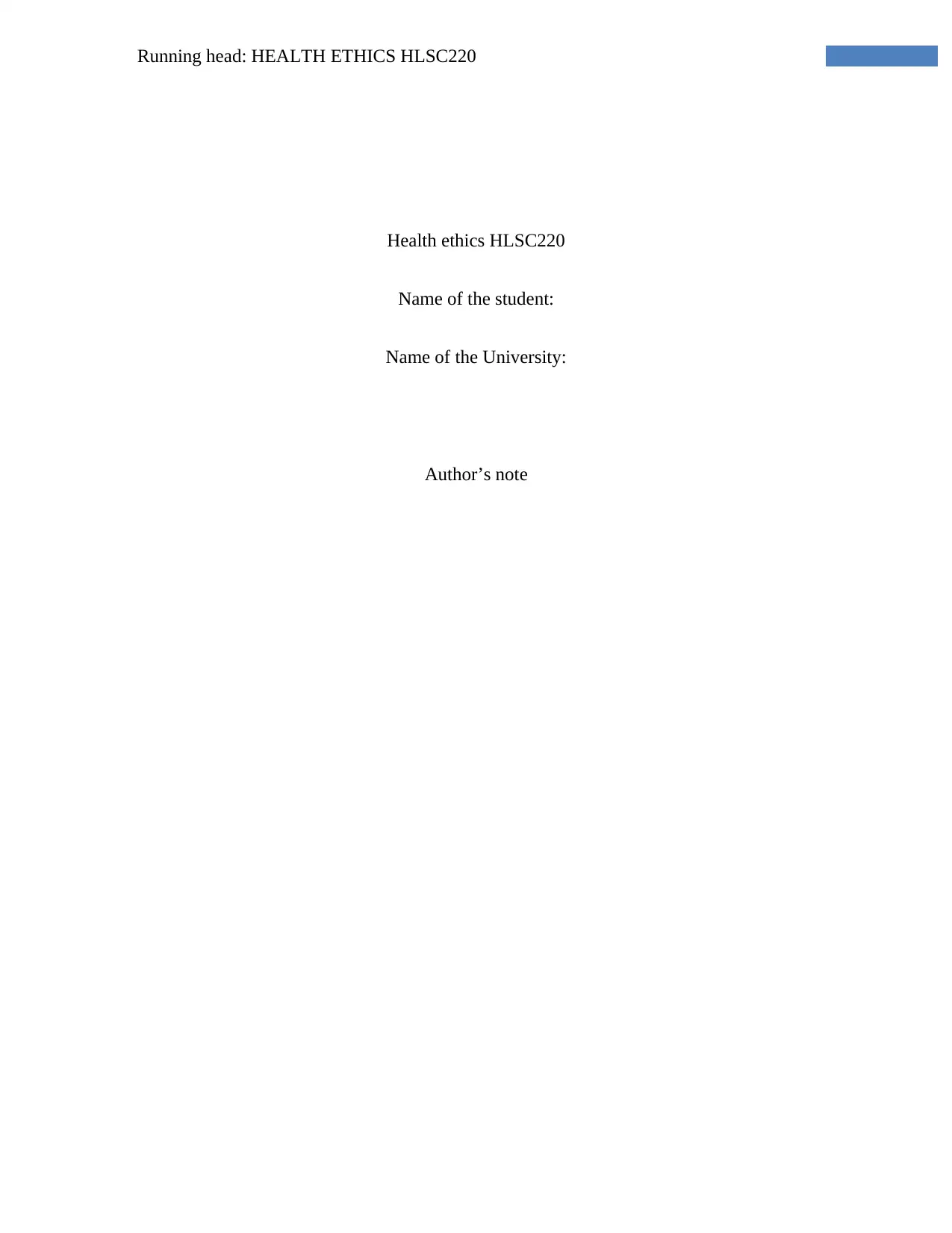
Running head: HEALTH ETHICS HLSC220
Health ethics HLSC220
Name of the student:
Name of the University:
Author’s note
Health ethics HLSC220
Name of the student:
Name of the University:
Author’s note
Paraphrase This Document
Need a fresh take? Get an instant paraphrase of this document with our AI Paraphraser
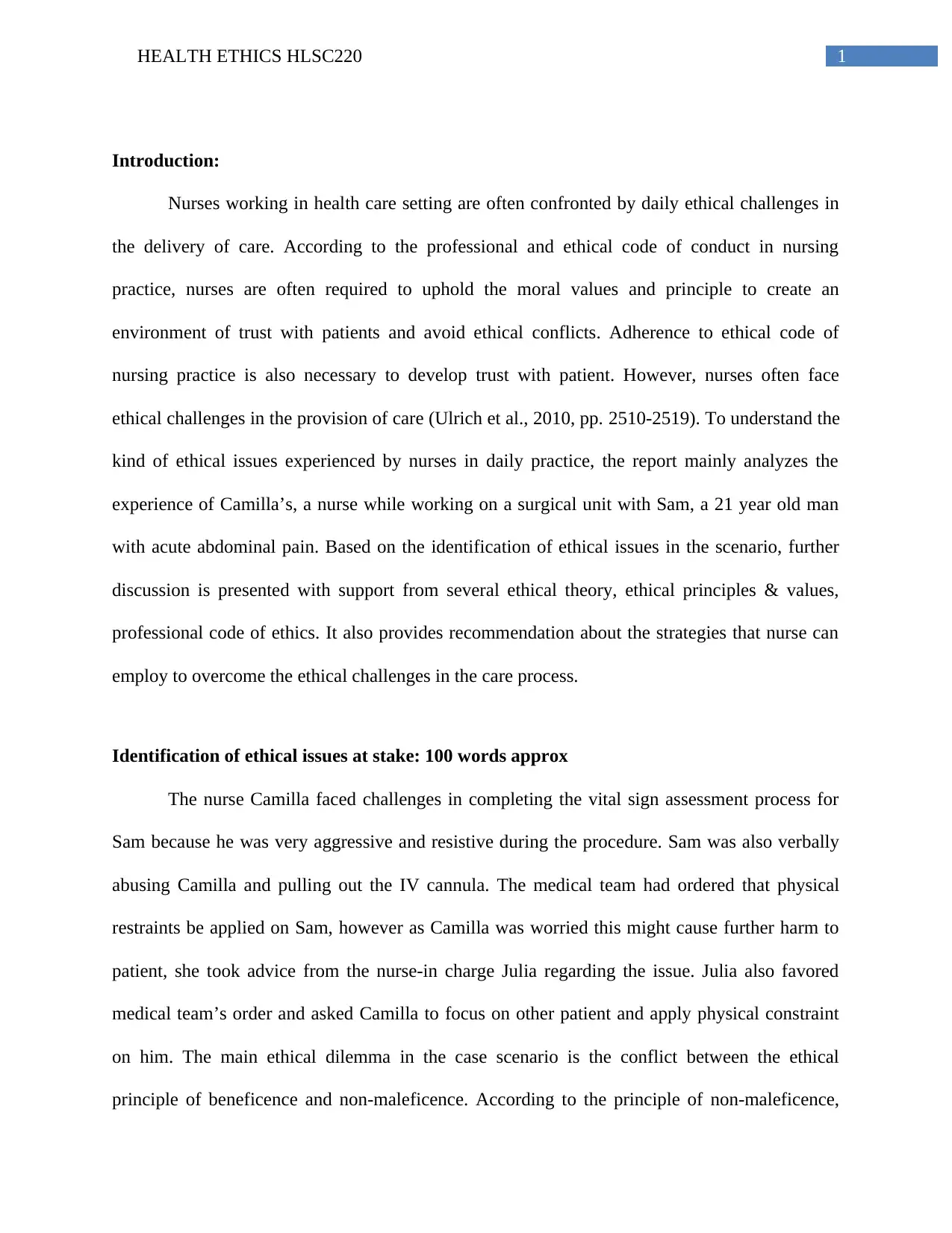
1HEALTH ETHICS HLSC220
Introduction:
Nurses working in health care setting are often confronted by daily ethical challenges in
the delivery of care. According to the professional and ethical code of conduct in nursing
practice, nurses are often required to uphold the moral values and principle to create an
environment of trust with patients and avoid ethical conflicts. Adherence to ethical code of
nursing practice is also necessary to develop trust with patient. However, nurses often face
ethical challenges in the provision of care (Ulrich et al., 2010, pp. 2510-2519). To understand the
kind of ethical issues experienced by nurses in daily practice, the report mainly analyzes the
experience of Camilla’s, a nurse while working on a surgical unit with Sam, a 21 year old man
with acute abdominal pain. Based on the identification of ethical issues in the scenario, further
discussion is presented with support from several ethical theory, ethical principles & values,
professional code of ethics. It also provides recommendation about the strategies that nurse can
employ to overcome the ethical challenges in the care process.
Identification of ethical issues at stake: 100 words approx
The nurse Camilla faced challenges in completing the vital sign assessment process for
Sam because he was very aggressive and resistive during the procedure. Sam was also verbally
abusing Camilla and pulling out the IV cannula. The medical team had ordered that physical
restraints be applied on Sam, however as Camilla was worried this might cause further harm to
patient, she took advice from the nurse-in charge Julia regarding the issue. Julia also favored
medical team’s order and asked Camilla to focus on other patient and apply physical constraint
on him. The main ethical dilemma in the case scenario is the conflict between the ethical
principle of beneficence and non-maleficence. According to the principle of non-maleficence,
Introduction:
Nurses working in health care setting are often confronted by daily ethical challenges in
the delivery of care. According to the professional and ethical code of conduct in nursing
practice, nurses are often required to uphold the moral values and principle to create an
environment of trust with patients and avoid ethical conflicts. Adherence to ethical code of
nursing practice is also necessary to develop trust with patient. However, nurses often face
ethical challenges in the provision of care (Ulrich et al., 2010, pp. 2510-2519). To understand the
kind of ethical issues experienced by nurses in daily practice, the report mainly analyzes the
experience of Camilla’s, a nurse while working on a surgical unit with Sam, a 21 year old man
with acute abdominal pain. Based on the identification of ethical issues in the scenario, further
discussion is presented with support from several ethical theory, ethical principles & values,
professional code of ethics. It also provides recommendation about the strategies that nurse can
employ to overcome the ethical challenges in the care process.
Identification of ethical issues at stake: 100 words approx
The nurse Camilla faced challenges in completing the vital sign assessment process for
Sam because he was very aggressive and resistive during the procedure. Sam was also verbally
abusing Camilla and pulling out the IV cannula. The medical team had ordered that physical
restraints be applied on Sam, however as Camilla was worried this might cause further harm to
patient, she took advice from the nurse-in charge Julia regarding the issue. Julia also favored
medical team’s order and asked Camilla to focus on other patient and apply physical constraint
on him. The main ethical dilemma in the case scenario is the conflict between the ethical
principle of beneficence and non-maleficence. According to the principle of non-maleficence,
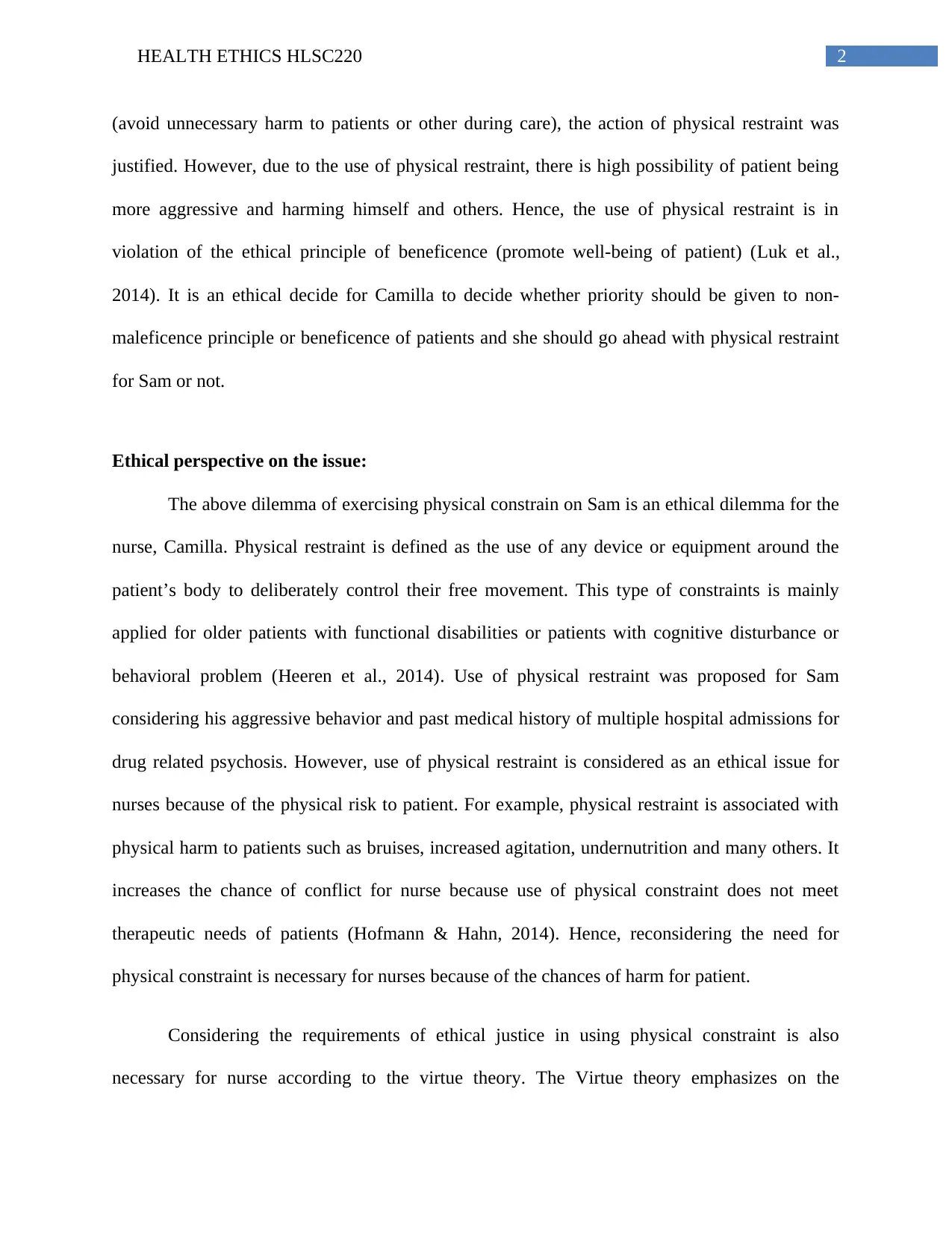
2HEALTH ETHICS HLSC220
(avoid unnecessary harm to patients or other during care), the action of physical restraint was
justified. However, due to the use of physical restraint, there is high possibility of patient being
more aggressive and harming himself and others. Hence, the use of physical restraint is in
violation of the ethical principle of beneficence (promote well-being of patient) (Luk et al.,
2014). It is an ethical decide for Camilla to decide whether priority should be given to non-
maleficence principle or beneficence of patients and she should go ahead with physical restraint
for Sam or not.
Ethical perspective on the issue:
The above dilemma of exercising physical constrain on Sam is an ethical dilemma for the
nurse, Camilla. Physical restraint is defined as the use of any device or equipment around the
patient’s body to deliberately control their free movement. This type of constraints is mainly
applied for older patients with functional disabilities or patients with cognitive disturbance or
behavioral problem (Heeren et al., 2014). Use of physical restraint was proposed for Sam
considering his aggressive behavior and past medical history of multiple hospital admissions for
drug related psychosis. However, use of physical restraint is considered as an ethical issue for
nurses because of the physical risk to patient. For example, physical restraint is associated with
physical harm to patients such as bruises, increased agitation, undernutrition and many others. It
increases the chance of conflict for nurse because use of physical constraint does not meet
therapeutic needs of patients (Hofmann & Hahn, 2014). Hence, reconsidering the need for
physical constraint is necessary for nurses because of the chances of harm for patient.
Considering the requirements of ethical justice in using physical constraint is also
necessary for nurse according to the virtue theory. The Virtue theory emphasizes on the
(avoid unnecessary harm to patients or other during care), the action of physical restraint was
justified. However, due to the use of physical restraint, there is high possibility of patient being
more aggressive and harming himself and others. Hence, the use of physical restraint is in
violation of the ethical principle of beneficence (promote well-being of patient) (Luk et al.,
2014). It is an ethical decide for Camilla to decide whether priority should be given to non-
maleficence principle or beneficence of patients and she should go ahead with physical restraint
for Sam or not.
Ethical perspective on the issue:
The above dilemma of exercising physical constrain on Sam is an ethical dilemma for the
nurse, Camilla. Physical restraint is defined as the use of any device or equipment around the
patient’s body to deliberately control their free movement. This type of constraints is mainly
applied for older patients with functional disabilities or patients with cognitive disturbance or
behavioral problem (Heeren et al., 2014). Use of physical restraint was proposed for Sam
considering his aggressive behavior and past medical history of multiple hospital admissions for
drug related psychosis. However, use of physical restraint is considered as an ethical issue for
nurses because of the physical risk to patient. For example, physical restraint is associated with
physical harm to patients such as bruises, increased agitation, undernutrition and many others. It
increases the chance of conflict for nurse because use of physical constraint does not meet
therapeutic needs of patients (Hofmann & Hahn, 2014). Hence, reconsidering the need for
physical constraint is necessary for nurses because of the chances of harm for patient.
Considering the requirements of ethical justice in using physical constraint is also
necessary for nurse according to the virtue theory. The Virtue theory emphasizes on the
⊘ This is a preview!⊘
Do you want full access?
Subscribe today to unlock all pages.

Trusted by 1+ million students worldwide
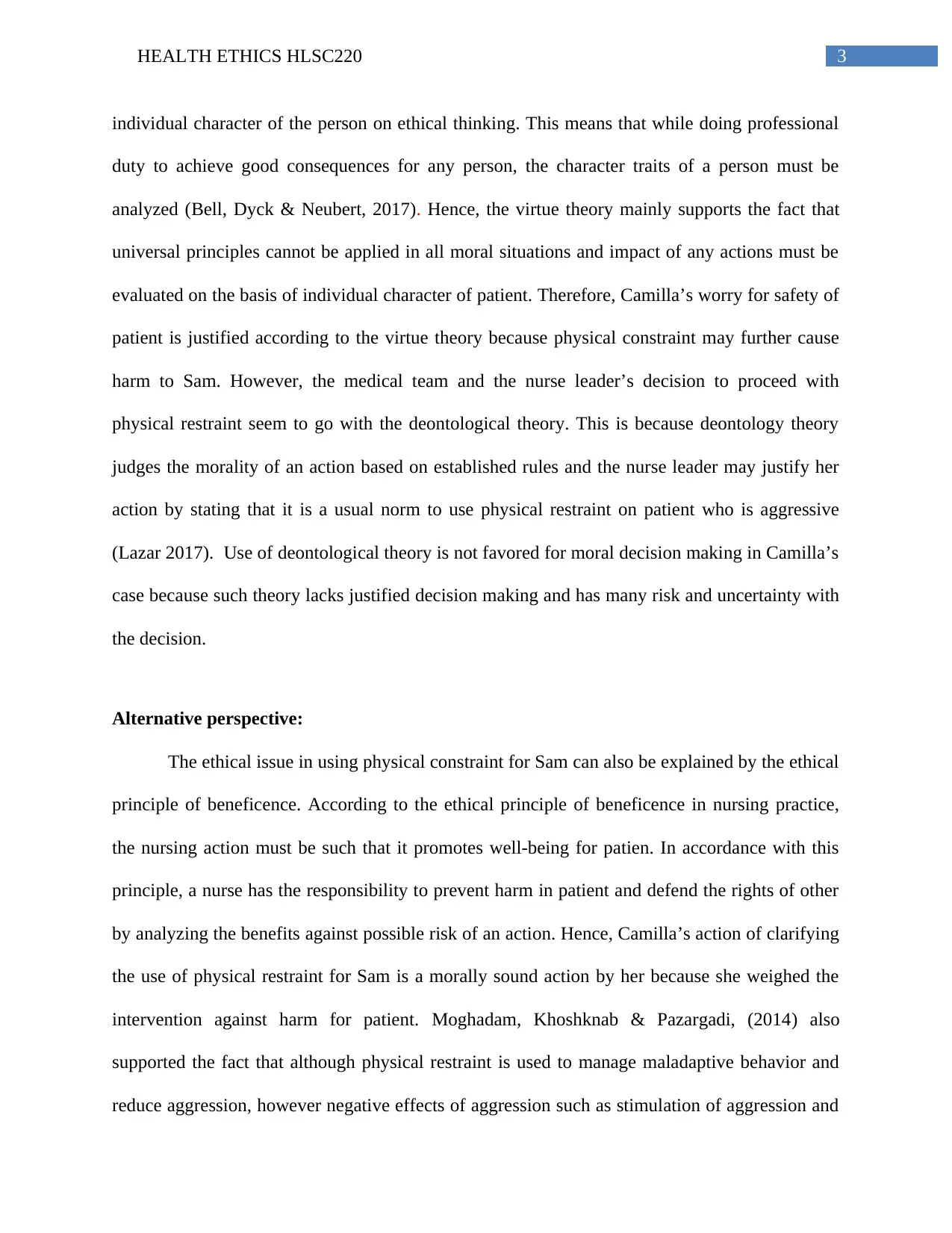
3HEALTH ETHICS HLSC220
individual character of the person on ethical thinking. This means that while doing professional
duty to achieve good consequences for any person, the character traits of a person must be
analyzed (Bell, Dyck & Neubert, 2017). Hence, the virtue theory mainly supports the fact that
universal principles cannot be applied in all moral situations and impact of any actions must be
evaluated on the basis of individual character of patient. Therefore, Camilla’s worry for safety of
patient is justified according to the virtue theory because physical constraint may further cause
harm to Sam. However, the medical team and the nurse leader’s decision to proceed with
physical restraint seem to go with the deontological theory. This is because deontology theory
judges the morality of an action based on established rules and the nurse leader may justify her
action by stating that it is a usual norm to use physical restraint on patient who is aggressive
(Lazar 2017). Use of deontological theory is not favored for moral decision making in Camilla’s
case because such theory lacks justified decision making and has many risk and uncertainty with
the decision.
Alternative perspective:
The ethical issue in using physical constraint for Sam can also be explained by the ethical
principle of beneficence. According to the ethical principle of beneficence in nursing practice,
the nursing action must be such that it promotes well-being for patien. In accordance with this
principle, a nurse has the responsibility to prevent harm in patient and defend the rights of other
by analyzing the benefits against possible risk of an action. Hence, Camilla’s action of clarifying
the use of physical restraint for Sam is a morally sound action by her because she weighed the
intervention against harm for patient. Moghadam, Khoshknab & Pazargadi, (2014) also
supported the fact that although physical restraint is used to manage maladaptive behavior and
reduce aggression, however negative effects of aggression such as stimulation of aggression and
individual character of the person on ethical thinking. This means that while doing professional
duty to achieve good consequences for any person, the character traits of a person must be
analyzed (Bell, Dyck & Neubert, 2017). Hence, the virtue theory mainly supports the fact that
universal principles cannot be applied in all moral situations and impact of any actions must be
evaluated on the basis of individual character of patient. Therefore, Camilla’s worry for safety of
patient is justified according to the virtue theory because physical constraint may further cause
harm to Sam. However, the medical team and the nurse leader’s decision to proceed with
physical restraint seem to go with the deontological theory. This is because deontology theory
judges the morality of an action based on established rules and the nurse leader may justify her
action by stating that it is a usual norm to use physical restraint on patient who is aggressive
(Lazar 2017). Use of deontological theory is not favored for moral decision making in Camilla’s
case because such theory lacks justified decision making and has many risk and uncertainty with
the decision.
Alternative perspective:
The ethical issue in using physical constraint for Sam can also be explained by the ethical
principle of beneficence. According to the ethical principle of beneficence in nursing practice,
the nursing action must be such that it promotes well-being for patien. In accordance with this
principle, a nurse has the responsibility to prevent harm in patient and defend the rights of other
by analyzing the benefits against possible risk of an action. Hence, Camilla’s action of clarifying
the use of physical restraint for Sam is a morally sound action by her because she weighed the
intervention against harm for patient. Moghadam, Khoshknab & Pazargadi, (2014) also
supported the fact that although physical restraint is used to manage maladaptive behavior and
reduce aggression, however negative effects of aggression such as stimulation of aggression and
Paraphrase This Document
Need a fresh take? Get an instant paraphrase of this document with our AI Paraphraser
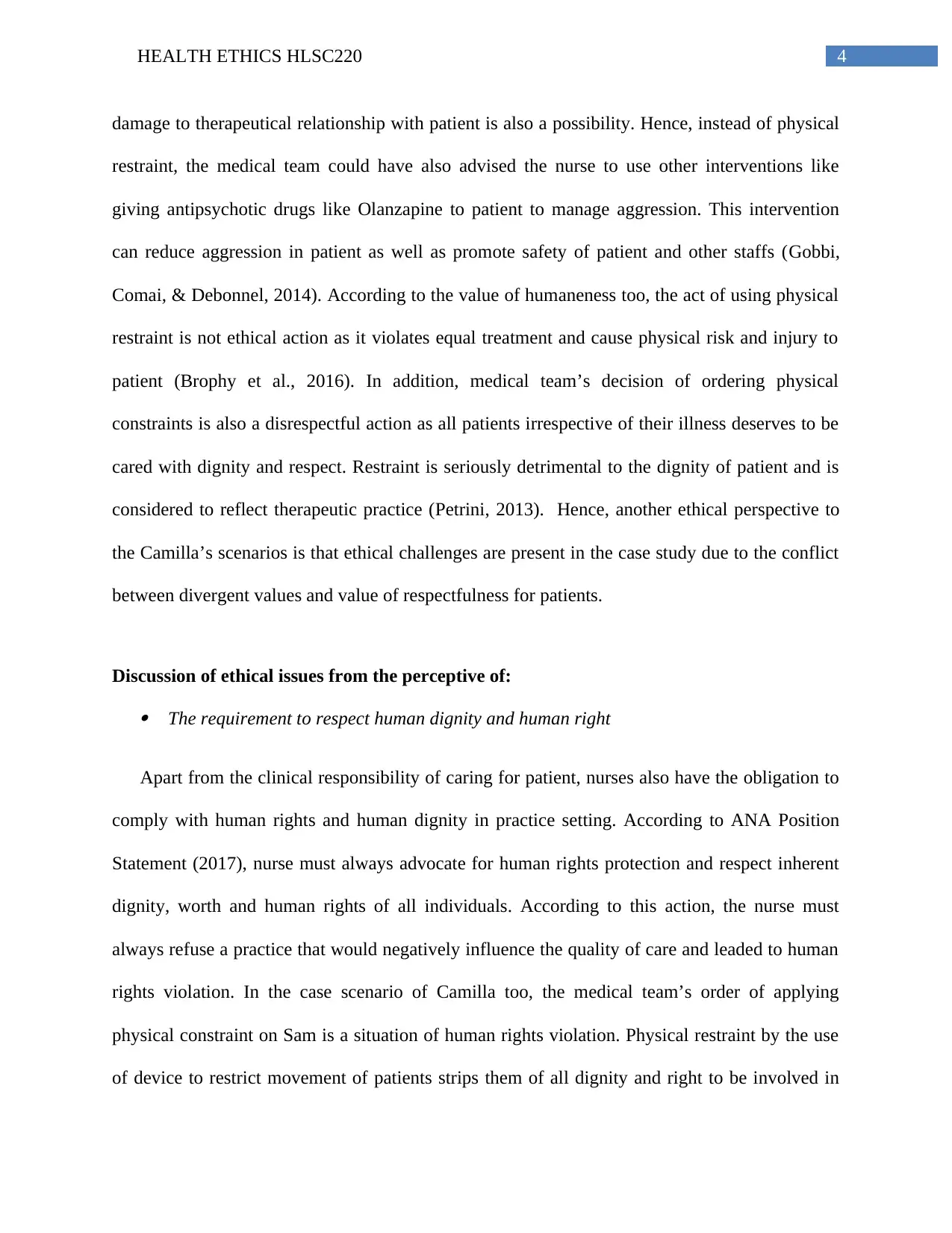
4HEALTH ETHICS HLSC220
damage to therapeutical relationship with patient is also a possibility. Hence, instead of physical
restraint, the medical team could have also advised the nurse to use other interventions like
giving antipsychotic drugs like Olanzapine to patient to manage aggression. This intervention
can reduce aggression in patient as well as promote safety of patient and other staffs (Gobbi,
Comai, & Debonnel, 2014). According to the value of humaneness too, the act of using physical
restraint is not ethical action as it violates equal treatment and cause physical risk and injury to
patient (Brophy et al., 2016). In addition, medical team’s decision of ordering physical
constraints is also a disrespectful action as all patients irrespective of their illness deserves to be
cared with dignity and respect. Restraint is seriously detrimental to the dignity of patient and is
considered to reflect therapeutic practice (Petrini, 2013). Hence, another ethical perspective to
the Camilla’s scenarios is that ethical challenges are present in the case study due to the conflict
between divergent values and value of respectfulness for patients.
Discussion of ethical issues from the perceptive of: The requirement to respect human dignity and human right
Apart from the clinical responsibility of caring for patient, nurses also have the obligation to
comply with human rights and human dignity in practice setting. According to ANA Position
Statement (2017), nurse must always advocate for human rights protection and respect inherent
dignity, worth and human rights of all individuals. According to this action, the nurse must
always refuse a practice that would negatively influence the quality of care and leaded to human
rights violation. In the case scenario of Camilla too, the medical team’s order of applying
physical constraint on Sam is a situation of human rights violation. Physical restraint by the use
of device to restrict movement of patients strips them of all dignity and right to be involved in
damage to therapeutical relationship with patient is also a possibility. Hence, instead of physical
restraint, the medical team could have also advised the nurse to use other interventions like
giving antipsychotic drugs like Olanzapine to patient to manage aggression. This intervention
can reduce aggression in patient as well as promote safety of patient and other staffs (Gobbi,
Comai, & Debonnel, 2014). According to the value of humaneness too, the act of using physical
restraint is not ethical action as it violates equal treatment and cause physical risk and injury to
patient (Brophy et al., 2016). In addition, medical team’s decision of ordering physical
constraints is also a disrespectful action as all patients irrespective of their illness deserves to be
cared with dignity and respect. Restraint is seriously detrimental to the dignity of patient and is
considered to reflect therapeutic practice (Petrini, 2013). Hence, another ethical perspective to
the Camilla’s scenarios is that ethical challenges are present in the case study due to the conflict
between divergent values and value of respectfulness for patients.
Discussion of ethical issues from the perceptive of: The requirement to respect human dignity and human right
Apart from the clinical responsibility of caring for patient, nurses also have the obligation to
comply with human rights and human dignity in practice setting. According to ANA Position
Statement (2017), nurse must always advocate for human rights protection and respect inherent
dignity, worth and human rights of all individuals. According to this action, the nurse must
always refuse a practice that would negatively influence the quality of care and leaded to human
rights violation. In the case scenario of Camilla too, the medical team’s order of applying
physical constraint on Sam is a situation of human rights violation. Physical restraint by the use
of device to restrict movement of patients strips them of all dignity and right to be involved in

5HEALTH ETHICS HLSC220
treatment. However, using this strategy to control aggressive and uncooperative patient is an
indication that health staffs lack training to work with such patient. Hence, to protect harm to
patient, the nurse Camilla must analyze the action on ground of human rights and human dignity
and take the step to deny such practice. This is within the provision of nursing practice. In
addition, she can also take alternative option possible to minimize negative ethical consequence
and harm to patient.
your future profession’s codes of ethics/ professional conduct & professional standards
According to the Code of Ethics for Nurses in Australia, they must value access to quality
nursing care for all people. In the context of valuing quality nursing care for all people, it means
that nurse must accept their moral and legal responsibilities to provide safe and competent care
and have all the right to question any nursing intervention that is potentially unethical or illegal
(Code of Ethics for Nurses in Australia, 2017). In this context, it can be said that the nursing
intervention of using physical restraint for Sam is an unethical issue as it will lead to harm for
patient and violate the requirements for safe and competent care. There are high chances of
patient safety related issues in using physical restraint as it will increase agitation, cause skin
injuries or restrict circulation and lead to self-harm consequences (Hughes & Lane, 2016).
Hence, according to the code of ethics, Camilla has all the rights to question such treatment and
consider the safety of patient above all things. Another important value statement of the Code of
ethics is that nurses must value kindness and respect for self and others. According to this
statement, the nurse have the obligation to respect and preserved the dignity of people by
practicing kindness and recognizing vulnerability of the patient (Code of Ethics for Nurses in
Australia, 2017). From this perspective too, the act of using physical restraint is an ethical issue
as it will give feelings of disrespect to Sam and it will be harsh method of nursing care.
treatment. However, using this strategy to control aggressive and uncooperative patient is an
indication that health staffs lack training to work with such patient. Hence, to protect harm to
patient, the nurse Camilla must analyze the action on ground of human rights and human dignity
and take the step to deny such practice. This is within the provision of nursing practice. In
addition, she can also take alternative option possible to minimize negative ethical consequence
and harm to patient.
your future profession’s codes of ethics/ professional conduct & professional standards
According to the Code of Ethics for Nurses in Australia, they must value access to quality
nursing care for all people. In the context of valuing quality nursing care for all people, it means
that nurse must accept their moral and legal responsibilities to provide safe and competent care
and have all the right to question any nursing intervention that is potentially unethical or illegal
(Code of Ethics for Nurses in Australia, 2017). In this context, it can be said that the nursing
intervention of using physical restraint for Sam is an unethical issue as it will lead to harm for
patient and violate the requirements for safe and competent care. There are high chances of
patient safety related issues in using physical restraint as it will increase agitation, cause skin
injuries or restrict circulation and lead to self-harm consequences (Hughes & Lane, 2016).
Hence, according to the code of ethics, Camilla has all the rights to question such treatment and
consider the safety of patient above all things. Another important value statement of the Code of
ethics is that nurses must value kindness and respect for self and others. According to this
statement, the nurse have the obligation to respect and preserved the dignity of people by
practicing kindness and recognizing vulnerability of the patient (Code of Ethics for Nurses in
Australia, 2017). From this perspective too, the act of using physical restraint is an ethical issue
as it will give feelings of disrespect to Sam and it will be harsh method of nursing care.
⊘ This is a preview!⊘
Do you want full access?
Subscribe today to unlock all pages.

Trusted by 1+ million students worldwide
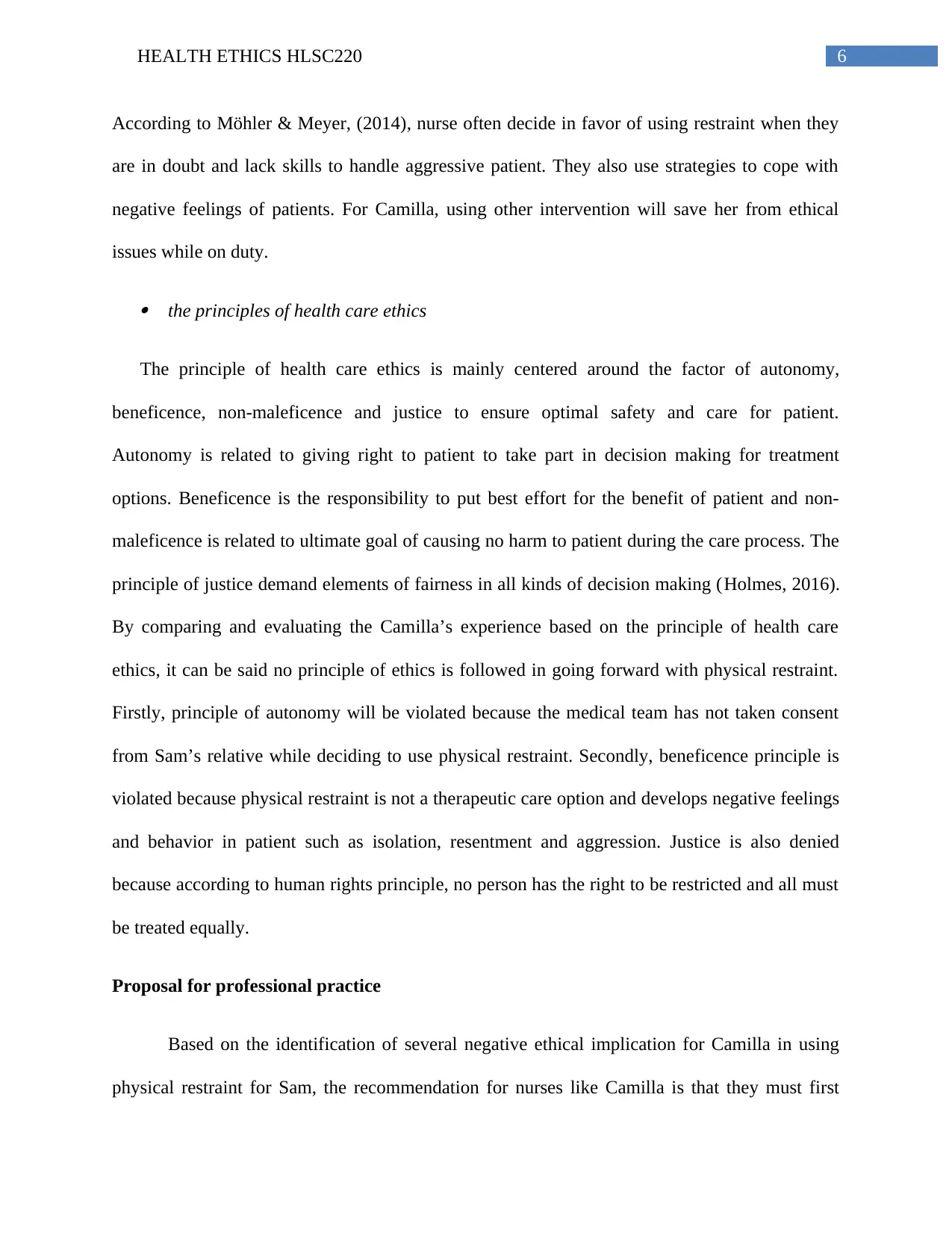
6HEALTH ETHICS HLSC220
According to Möhler & Meyer, (2014), nurse often decide in favor of using restraint when they
are in doubt and lack skills to handle aggressive patient. They also use strategies to cope with
negative feelings of patients. For Camilla, using other intervention will save her from ethical
issues while on duty.
the principles of health care ethics
The principle of health care ethics is mainly centered around the factor of autonomy,
beneficence, non-maleficence and justice to ensure optimal safety and care for patient.
Autonomy is related to giving right to patient to take part in decision making for treatment
options. Beneficence is the responsibility to put best effort for the benefit of patient and non-
maleficence is related to ultimate goal of causing no harm to patient during the care process. The
principle of justice demand elements of fairness in all kinds of decision making (Holmes, 2016).
By comparing and evaluating the Camilla’s experience based on the principle of health care
ethics, it can be said no principle of ethics is followed in going forward with physical restraint.
Firstly, principle of autonomy will be violated because the medical team has not taken consent
from Sam’s relative while deciding to use physical restraint. Secondly, beneficence principle is
violated because physical restraint is not a therapeutic care option and develops negative feelings
and behavior in patient such as isolation, resentment and aggression. Justice is also denied
because according to human rights principle, no person has the right to be restricted and all must
be treated equally.
Proposal for professional practice
Based on the identification of several negative ethical implication for Camilla in using
physical restraint for Sam, the recommendation for nurses like Camilla is that they must first
According to Möhler & Meyer, (2014), nurse often decide in favor of using restraint when they
are in doubt and lack skills to handle aggressive patient. They also use strategies to cope with
negative feelings of patients. For Camilla, using other intervention will save her from ethical
issues while on duty.
the principles of health care ethics
The principle of health care ethics is mainly centered around the factor of autonomy,
beneficence, non-maleficence and justice to ensure optimal safety and care for patient.
Autonomy is related to giving right to patient to take part in decision making for treatment
options. Beneficence is the responsibility to put best effort for the benefit of patient and non-
maleficence is related to ultimate goal of causing no harm to patient during the care process. The
principle of justice demand elements of fairness in all kinds of decision making (Holmes, 2016).
By comparing and evaluating the Camilla’s experience based on the principle of health care
ethics, it can be said no principle of ethics is followed in going forward with physical restraint.
Firstly, principle of autonomy will be violated because the medical team has not taken consent
from Sam’s relative while deciding to use physical restraint. Secondly, beneficence principle is
violated because physical restraint is not a therapeutic care option and develops negative feelings
and behavior in patient such as isolation, resentment and aggression. Justice is also denied
because according to human rights principle, no person has the right to be restricted and all must
be treated equally.
Proposal for professional practice
Based on the identification of several negative ethical implication for Camilla in using
physical restraint for Sam, the recommendation for nurses like Camilla is that they must first
Paraphrase This Document
Need a fresh take? Get an instant paraphrase of this document with our AI Paraphraser
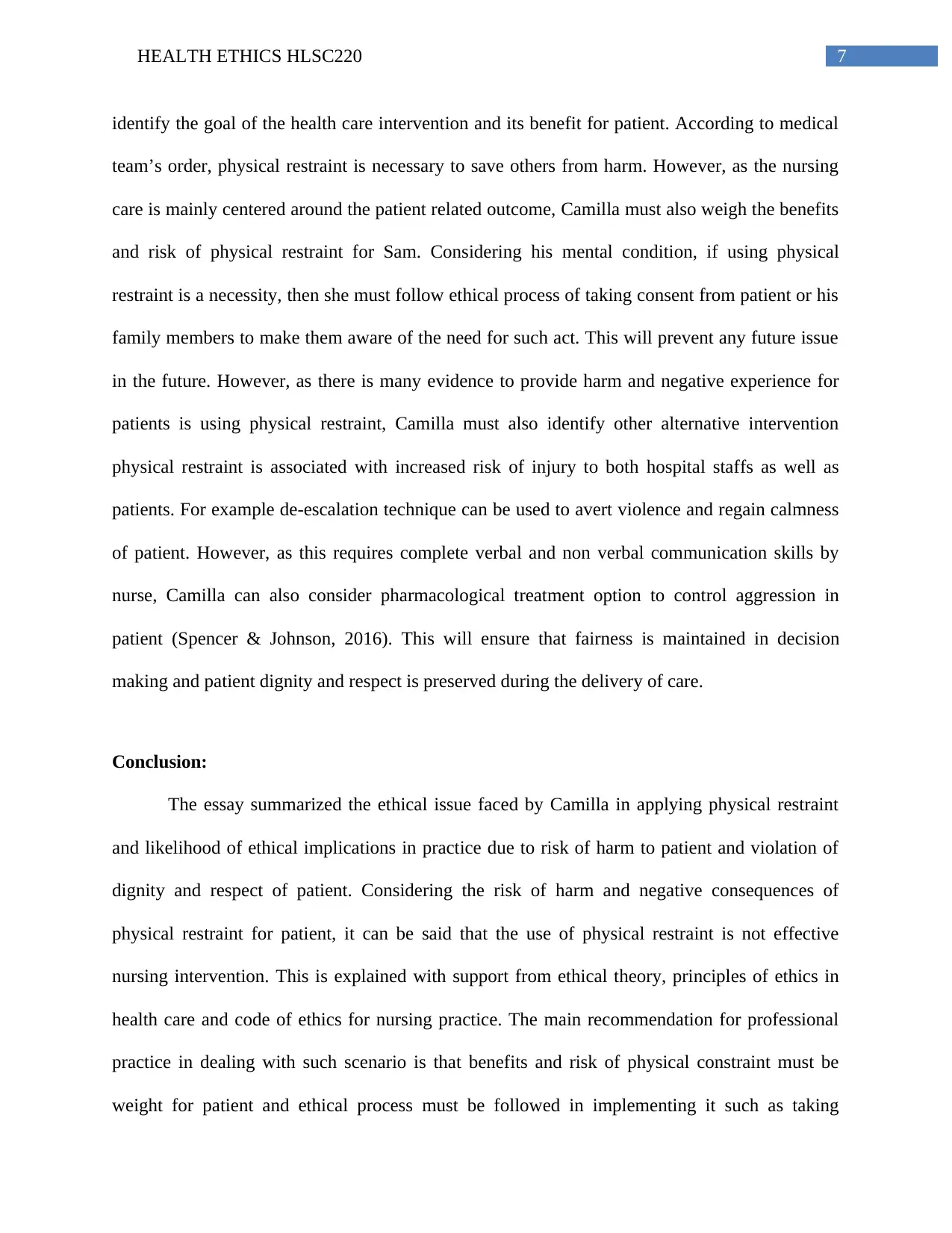
7HEALTH ETHICS HLSC220
identify the goal of the health care intervention and its benefit for patient. According to medical
team’s order, physical restraint is necessary to save others from harm. However, as the nursing
care is mainly centered around the patient related outcome, Camilla must also weigh the benefits
and risk of physical restraint for Sam. Considering his mental condition, if using physical
restraint is a necessity, then she must follow ethical process of taking consent from patient or his
family members to make them aware of the need for such act. This will prevent any future issue
in the future. However, as there is many evidence to provide harm and negative experience for
patients is using physical restraint, Camilla must also identify other alternative intervention
physical restraint is associated with increased risk of injury to both hospital staffs as well as
patients. For example de-escalation technique can be used to avert violence and regain calmness
of patient. However, as this requires complete verbal and non verbal communication skills by
nurse, Camilla can also consider pharmacological treatment option to control aggression in
patient (Spencer & Johnson, 2016). This will ensure that fairness is maintained in decision
making and patient dignity and respect is preserved during the delivery of care.
Conclusion:
The essay summarized the ethical issue faced by Camilla in applying physical restraint
and likelihood of ethical implications in practice due to risk of harm to patient and violation of
dignity and respect of patient. Considering the risk of harm and negative consequences of
physical restraint for patient, it can be said that the use of physical restraint is not effective
nursing intervention. This is explained with support from ethical theory, principles of ethics in
health care and code of ethics for nursing practice. The main recommendation for professional
practice in dealing with such scenario is that benefits and risk of physical constraint must be
weight for patient and ethical process must be followed in implementing it such as taking
identify the goal of the health care intervention and its benefit for patient. According to medical
team’s order, physical restraint is necessary to save others from harm. However, as the nursing
care is mainly centered around the patient related outcome, Camilla must also weigh the benefits
and risk of physical restraint for Sam. Considering his mental condition, if using physical
restraint is a necessity, then she must follow ethical process of taking consent from patient or his
family members to make them aware of the need for such act. This will prevent any future issue
in the future. However, as there is many evidence to provide harm and negative experience for
patients is using physical restraint, Camilla must also identify other alternative intervention
physical restraint is associated with increased risk of injury to both hospital staffs as well as
patients. For example de-escalation technique can be used to avert violence and regain calmness
of patient. However, as this requires complete verbal and non verbal communication skills by
nurse, Camilla can also consider pharmacological treatment option to control aggression in
patient (Spencer & Johnson, 2016). This will ensure that fairness is maintained in decision
making and patient dignity and respect is preserved during the delivery of care.
Conclusion:
The essay summarized the ethical issue faced by Camilla in applying physical restraint
and likelihood of ethical implications in practice due to risk of harm to patient and violation of
dignity and respect of patient. Considering the risk of harm and negative consequences of
physical restraint for patient, it can be said that the use of physical restraint is not effective
nursing intervention. This is explained with support from ethical theory, principles of ethics in
health care and code of ethics for nursing practice. The main recommendation for professional
practice in dealing with such scenario is that benefits and risk of physical constraint must be
weight for patient and ethical process must be followed in implementing it such as taking
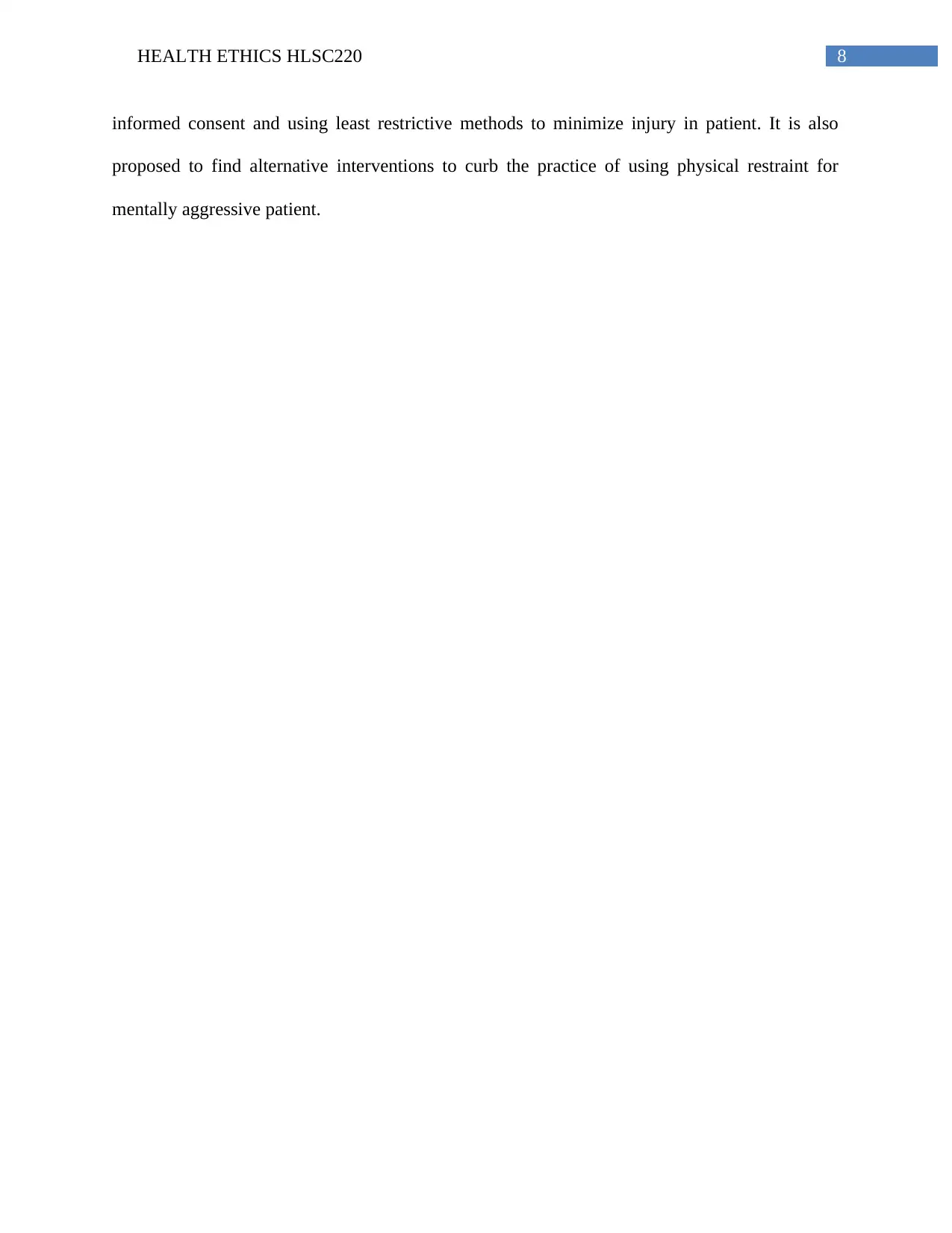
8HEALTH ETHICS HLSC220
informed consent and using least restrictive methods to minimize injury in patient. It is also
proposed to find alternative interventions to curb the practice of using physical restraint for
mentally aggressive patient.
informed consent and using least restrictive methods to minimize injury in patient. It is also
proposed to find alternative interventions to curb the practice of using physical restraint for
mentally aggressive patient.
⊘ This is a preview!⊘
Do you want full access?
Subscribe today to unlock all pages.

Trusted by 1+ million students worldwide
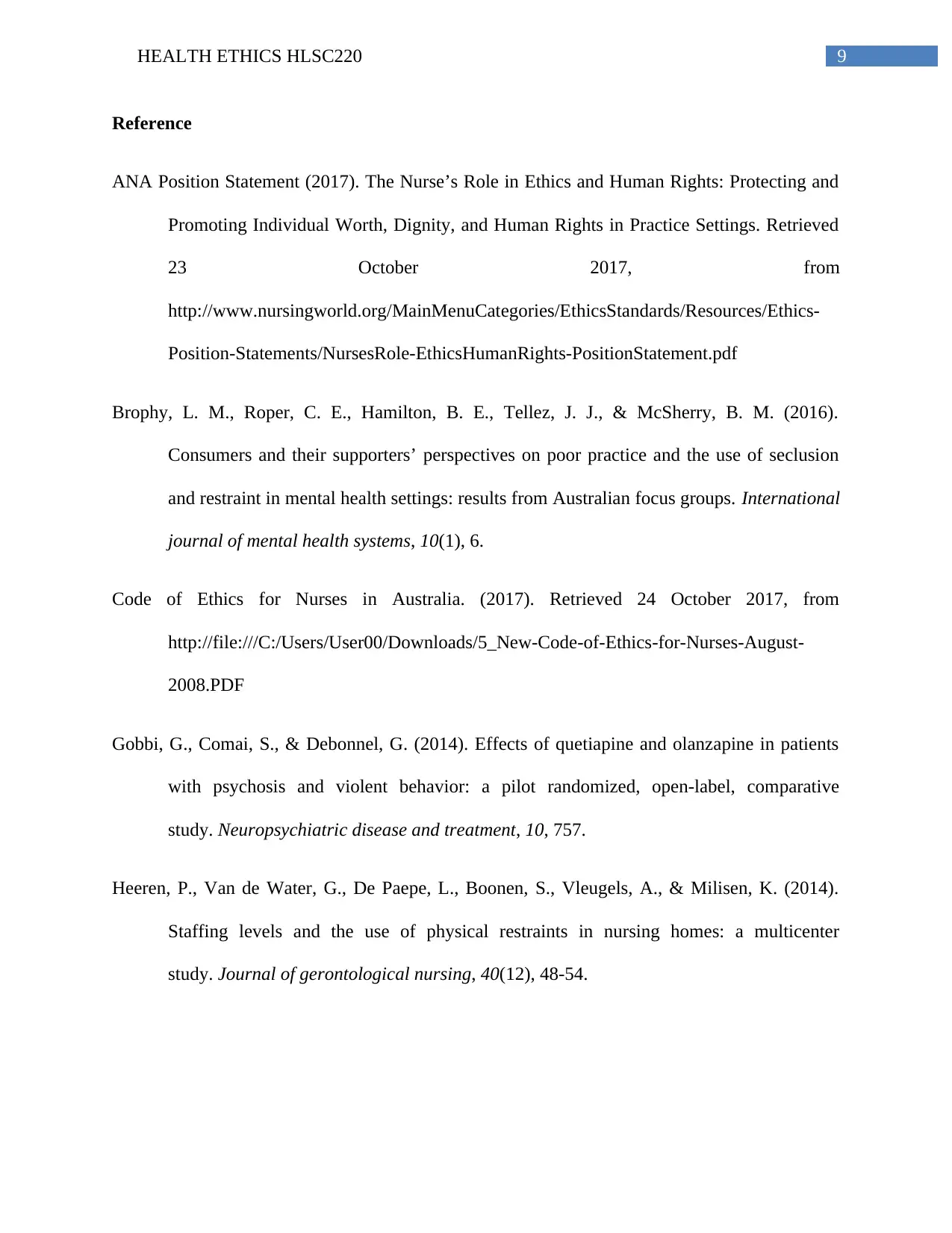
9HEALTH ETHICS HLSC220
Reference
ANA Position Statement (2017). The Nurse’s Role in Ethics and Human Rights: Protecting and
Promoting Individual Worth, Dignity, and Human Rights in Practice Settings. Retrieved
23 October 2017, from
http://www.nursingworld.org/MainMenuCategories/EthicsStandards/Resources/Ethics-
Position-Statements/NursesRole-EthicsHumanRights-PositionStatement.pdf
Brophy, L. M., Roper, C. E., Hamilton, B. E., Tellez, J. J., & McSherry, B. M. (2016).
Consumers and their supporters’ perspectives on poor practice and the use of seclusion
and restraint in mental health settings: results from Australian focus groups. International
journal of mental health systems, 10(1), 6.
Code of Ethics for Nurses in Australia. (2017). Retrieved 24 October 2017, from
http://file:///C:/Users/User00/Downloads/5_New-Code-of-Ethics-for-Nurses-August-
2008.PDF
Gobbi, G., Comai, S., & Debonnel, G. (2014). Effects of quetiapine and olanzapine in patients
with psychosis and violent behavior: a pilot randomized, open-label, comparative
study. Neuropsychiatric disease and treatment, 10, 757.
Heeren, P., Van de Water, G., De Paepe, L., Boonen, S., Vleugels, A., & Milisen, K. (2014).
Staffing levels and the use of physical restraints in nursing homes: a multicenter
study. Journal of gerontological nursing, 40(12), 48-54.
Reference
ANA Position Statement (2017). The Nurse’s Role in Ethics and Human Rights: Protecting and
Promoting Individual Worth, Dignity, and Human Rights in Practice Settings. Retrieved
23 October 2017, from
http://www.nursingworld.org/MainMenuCategories/EthicsStandards/Resources/Ethics-
Position-Statements/NursesRole-EthicsHumanRights-PositionStatement.pdf
Brophy, L. M., Roper, C. E., Hamilton, B. E., Tellez, J. J., & McSherry, B. M. (2016).
Consumers and their supporters’ perspectives on poor practice and the use of seclusion
and restraint in mental health settings: results from Australian focus groups. International
journal of mental health systems, 10(1), 6.
Code of Ethics for Nurses in Australia. (2017). Retrieved 24 October 2017, from
http://file:///C:/Users/User00/Downloads/5_New-Code-of-Ethics-for-Nurses-August-
2008.PDF
Gobbi, G., Comai, S., & Debonnel, G. (2014). Effects of quetiapine and olanzapine in patients
with psychosis and violent behavior: a pilot randomized, open-label, comparative
study. Neuropsychiatric disease and treatment, 10, 757.
Heeren, P., Van de Water, G., De Paepe, L., Boonen, S., Vleugels, A., & Milisen, K. (2014).
Staffing levels and the use of physical restraints in nursing homes: a multicenter
study. Journal of gerontological nursing, 40(12), 48-54.
Paraphrase This Document
Need a fresh take? Get an instant paraphrase of this document with our AI Paraphraser
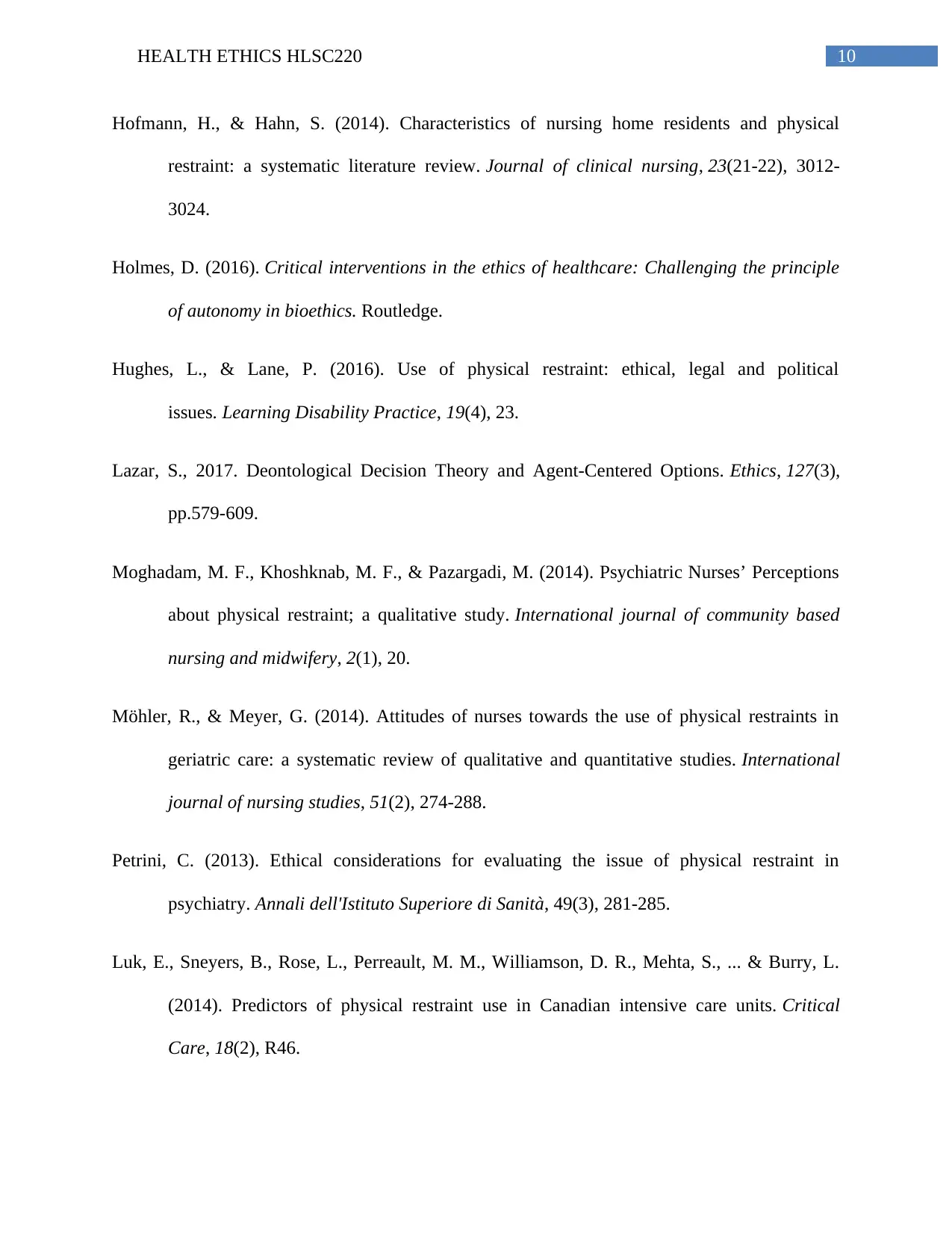
10HEALTH ETHICS HLSC220
Hofmann, H., & Hahn, S. (2014). Characteristics of nursing home residents and physical
restraint: a systematic literature review. Journal of clinical nursing, 23(21-22), 3012-
3024.
Holmes, D. (2016). Critical interventions in the ethics of healthcare: Challenging the principle
of autonomy in bioethics. Routledge.
Hughes, L., & Lane, P. (2016). Use of physical restraint: ethical, legal and political
issues. Learning Disability Practice, 19(4), 23.
Lazar, S., 2017. Deontological Decision Theory and Agent-Centered Options. Ethics, 127(3),
pp.579-609.
Moghadam, M. F., Khoshknab, M. F., & Pazargadi, M. (2014). Psychiatric Nurses’ Perceptions
about physical restraint; a qualitative study. International journal of community based
nursing and midwifery, 2(1), 20.
Möhler, R., & Meyer, G. (2014). Attitudes of nurses towards the use of physical restraints in
geriatric care: a systematic review of qualitative and quantitative studies. International
journal of nursing studies, 51(2), 274-288.
Petrini, C. (2013). Ethical considerations for evaluating the issue of physical restraint in
psychiatry. Annali dell'Istituto Superiore di Sanità, 49(3), 281-285.
Luk, E., Sneyers, B., Rose, L., Perreault, M. M., Williamson, D. R., Mehta, S., ... & Burry, L.
(2014). Predictors of physical restraint use in Canadian intensive care units. Critical
Care, 18(2), R46.
Hofmann, H., & Hahn, S. (2014). Characteristics of nursing home residents and physical
restraint: a systematic literature review. Journal of clinical nursing, 23(21-22), 3012-
3024.
Holmes, D. (2016). Critical interventions in the ethics of healthcare: Challenging the principle
of autonomy in bioethics. Routledge.
Hughes, L., & Lane, P. (2016). Use of physical restraint: ethical, legal and political
issues. Learning Disability Practice, 19(4), 23.
Lazar, S., 2017. Deontological Decision Theory and Agent-Centered Options. Ethics, 127(3),
pp.579-609.
Moghadam, M. F., Khoshknab, M. F., & Pazargadi, M. (2014). Psychiatric Nurses’ Perceptions
about physical restraint; a qualitative study. International journal of community based
nursing and midwifery, 2(1), 20.
Möhler, R., & Meyer, G. (2014). Attitudes of nurses towards the use of physical restraints in
geriatric care: a systematic review of qualitative and quantitative studies. International
journal of nursing studies, 51(2), 274-288.
Petrini, C. (2013). Ethical considerations for evaluating the issue of physical restraint in
psychiatry. Annali dell'Istituto Superiore di Sanità, 49(3), 281-285.
Luk, E., Sneyers, B., Rose, L., Perreault, M. M., Williamson, D. R., Mehta, S., ... & Burry, L.
(2014). Predictors of physical restraint use in Canadian intensive care units. Critical
Care, 18(2), R46.
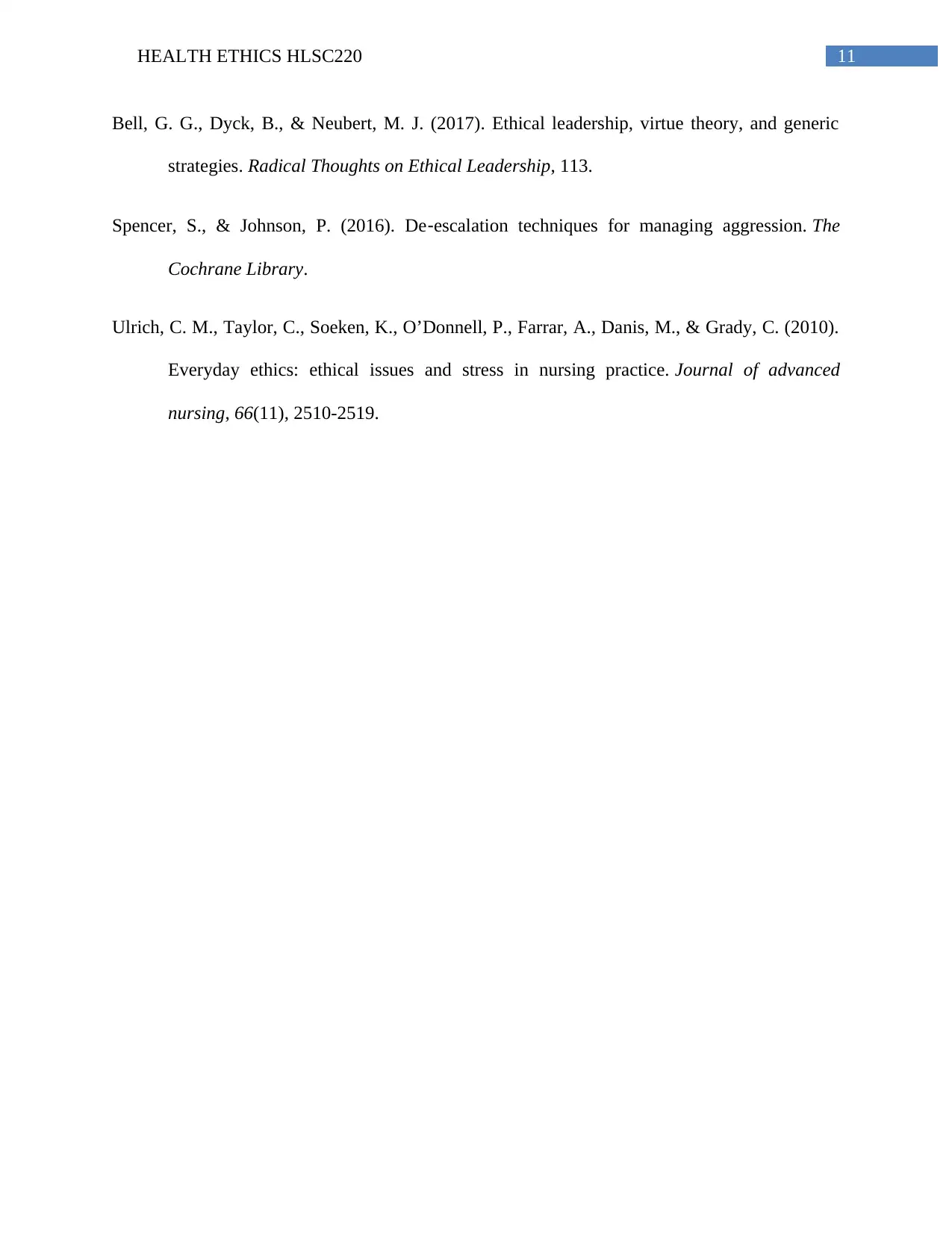
11HEALTH ETHICS HLSC220
Bell, G. G., Dyck, B., & Neubert, M. J. (2017). Ethical leadership, virtue theory, and generic
strategies. Radical Thoughts on Ethical Leadership, 113.
Spencer, S., & Johnson, P. (2016). De‐escalation techniques for managing aggression. The
Cochrane Library.
Ulrich, C. M., Taylor, C., Soeken, K., O’Donnell, P., Farrar, A., Danis, M., & Grady, C. (2010).
Everyday ethics: ethical issues and stress in nursing practice. Journal of advanced
nursing, 66(11), 2510-2519.
Bell, G. G., Dyck, B., & Neubert, M. J. (2017). Ethical leadership, virtue theory, and generic
strategies. Radical Thoughts on Ethical Leadership, 113.
Spencer, S., & Johnson, P. (2016). De‐escalation techniques for managing aggression. The
Cochrane Library.
Ulrich, C. M., Taylor, C., Soeken, K., O’Donnell, P., Farrar, A., Danis, M., & Grady, C. (2010).
Everyday ethics: ethical issues and stress in nursing practice. Journal of advanced
nursing, 66(11), 2510-2519.
⊘ This is a preview!⊘
Do you want full access?
Subscribe today to unlock all pages.

Trusted by 1+ million students worldwide
1 out of 12
Related Documents
Your All-in-One AI-Powered Toolkit for Academic Success.
+13062052269
info@desklib.com
Available 24*7 on WhatsApp / Email
![[object Object]](/_next/static/media/star-bottom.7253800d.svg)
Unlock your academic potential
Copyright © 2020–2025 A2Z Services. All Rights Reserved. Developed and managed by ZUCOL.





